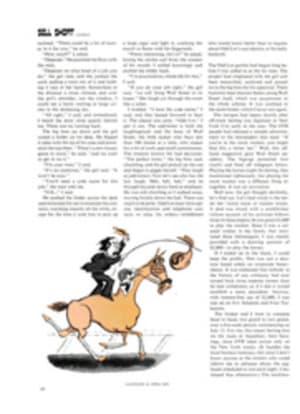
These Are Times of Technical Adjustment
When SPORTS ILLUSTRATED asked me to buck heads with Odd Lot and the horses by playing the stock market, I readily agreed. I was fascinated by the notion. I have been around horses all my life, and so has my wife. We are foxhunters. She actually does most of the work, grooming the horses and cleaning the tack. I muck out the stalls, so I do feel rather close to horses, although in a different sort of way than Odd Lot, I'm sure. Several friends and clients have racing stables, and I make it a point to visit the track a few times in the course of the year.
Familiar with both racing and the stock market, I felt from the start I was going to be at a disadvantage. I have no desire to alibi, but I simply was not going to have the number of opportunities that Odd Lot would have betting the races. When you have a commitment in the market, you can't change it every day. This is especially the case when you have only $2,000 to play with, because the brokerage commissions, surcharges, taxes and fees would really eat into your capital. I always tell a potential investor to stay away from Wall Street until he has at least $7,500 or $10,000 to spare. My typical client has $75,000 to $100,000 in the market, some considerably more; when an investor has a substantial sum I can spread it around in three or four different stocks to take advantage of special opportunities and also to cut the risk.
Any investment made in the market should be for more than five weeks. The best gains can be realized from longer-term positions, investing in a stock that will do well over a period of from six months to two years. This gives the company a chance to develop a following and allows the investor to take a capital gain.
Despite these handicaps, I was willing to take on Odd Lot and the horses. There was the sport of the challenge, and I would also be able to test the validity of my theory that an investor needed at least $7,500 to go into the market, even though that was a negative consideration.
I began devising my strategy. Because of the commissions and fees, I decided to buy one stock at a time. Instead of investing in a potential turnaround—some depressed electronics, steels or the like, that I figured just had to go up sometime—I would choose a stock that already had a following. So much for the game plan; now for the game.
MONDAY, JULY 12. The first day of competition and a dull one in the market with Dow Jones up only 1.60. I decide to wait until tomorrow.
JULY 13. The market had been up all the previous week but now it starts down. Indeed it is in a rout and the day ends with the Dow Jones off 11. Yet I take the plunge, buying 45 shares of Fred S. James & Company at 42‚Öû. The shares cost me $1,929.38, and even though I am a partner in my firm I have to pay the commission, $24.29, and the surcharge, $12.15. Despite the deteriorating market, I am optimistic about Fred S. James. An insurance brokerage company with an outstanding record of achievement, the company appears to have a good following among investors, and the stock has had a steady rise. A year ago it sold for $10.75 over the counter; only recently the company obtained a listing on the Big Board. With just a little luck and a continuation of momentum. I figure to sell my purchase at a 10%, profit in about two weeks. Odd Lot may have a hare's head start, but I am the tortoise.
JULY 14. The expected market stabilization took place today, but Fred S. James slipped downward and was off 114. Perhaps we got in at the end of the action here, and so instead of waiting two weeks I am now prepared to move out smartly into something else should the opportunity arise. Through the grapevine I hear that a relatively new company, International Foodservice Systems, could "go higher." Checking around, I discover that the company has received a good writeup in a service, or what horseplayers might call a tip sheet. International has a fine record of growth, and the youthful management appears to be highly regarded on The Street. I learn that the company president's name was Steven Sanford Fink but that he has changed it to Steven Sanford. Js this a warning of some kind? I call a broker who has his eye on the same kind of stock situations that interest me, and he says he has heard of International and the stock looks "pretty good." I telephone a friend in New York and he likes it. While I am mulling over the possibilities, I happen to mention it casually to one of my associates who has a dismal record in picking growth stocks. He passes off International as unglamorous and probably a loser. Based on his comment, I decide to buy International the very next morning.
JULY 15. Out of Fred S. James at 41‚⅛ and into International Foodservice Systems. I get $1,850.63 for my James, pay $23.51 commission, $11.76 surcharge, $2.25 tax and exactly 4¢ for the SEC fee. I am left with $1,813.07, not counting $34.18 unused in my account. I buy 75 shares of International at 23 5‚Öù for $1,771.88 and also pay $22.72 commission and $11.36 surcharge for a total expenditure of $1,805.96. In only two days I am behind more than $150, but I feel I am going places with International. People have to eat, don't they?
JULY 19-26. This week apparently marked the start of a mass diet by the country at large. International drops 1‚Öù. It is slowly bleeding me to death with fractional drops.
JULY 27. Down another 1‚⅛. I must get out!
JULY 28. Real estate investment trusts look like the answer. I have been following them for some months, and they pay good dividends, have good records of growth in earnings per share, sell at reasonable price/earning ratios and seem to have an excellent following. All these ingredients are appealing, but in checking around the office I find people rather lukewarm to the trusts as a whole. In fact, one of the partners says he remembers them doing badly back around 1930. I wasn't around at the time, nor was this particular type of investment. I don't think I'll check with this partner again for his opinions.
JULY 29. I finally dump International Foodservice Systems at 20‚⅛, and after paying fees wind up with $1,475.40.
JULY 30. I buy 45 shares of Wachovia Realty Investments, selling at 30 on the New York Stock Exchange. It appears to be a well-managed company and has a solid record of quarterly increases. I own some of this stock myself, and while this is usually the kiss of death, I feel we might have an exception here. Including commission and surcharge, my expenditure comes to $1,377.75. I also have $138.94 in my account. Watch me move with Wachovia.
AUGUST 2-3. No significant action. While I might have good value here, I need some movement if I am to beat Odd Lot by Friday the 13th, the last day of our betting duel.
AUGUST 4. One of the worst markets all year. My Wachovia held up O.K. and even rose Vs. A number of opportunities are appearing and the market certainly seems oversold, yet the selling continues. Should I change my game plan? Should I go short? Short on what? Anything! Tempting but it appears to be late for me to do that. Moreover, some stocks are falling so fast the chance to go short might not occur.
One thing is certain. I must move—and now. A research service I use is bullish about a company called Topper. I know a fellow who has a dog named Topper. Is this company a dog? The Topper Corporation specializes in toys, such as Suzy Homemaker dolls and Johnny Lightning cars. Moreover, Topper has recently signed a contract to produce toys under the Sesame Street label. As a general rule, any company that has nationwide consumer-usage overtones can expect a large-volume business bonanza that will reflect itself in higher prices for the stock. I decide I am going for Topper. It certainly isn't the best quality stock but we don't have much longer to go with this game, so the investment should be O.K. for a week or so.
AUGUST 5. Sold Wachovia at 30¼, but lost money because of commission, surcharge, tax and 3¢ SEC fee. I had laid out $1,377.75 for Wachovia, and I get back the net sum of $1,331.04. But there is no looking back, and so here I go on Topper. Using margin for the first time, I buy 100 shares at 17¾. My total expenditure is $1,812.13, and I am deeper in the hole, but as the market closes Topper is up 1¼ on 50,000 shares. This is a good sign to have a stock that advances on rising volume. It is on the most actively traded list, so hopefully other people feel the same as I do.
AUGUST 6. Euphoria at last! Topper closed at 19½. Again a big volume and again on the most active list. I go home for a happy weekend.
AUGUST 10. I am taking gas! Topper Corporation is lambasted in "Heard on the Street" column in The Wall Street Journal. It seems people can't say enough bad things about the company and as a result of the Journal article, the stock is doomed. There are sell orders galore as everyone tries to jump out, and Topper closes at 15‚Öû. More gas, please.
AUGUST 11. Topper is off only a quarter of a point. This is a moral victory, all things considered.
AUGUST 12. May I please have some more gas? Topper traded as low as 14‚⅛, ends the day at 15‚⅛.
AUGUST 13. Black Friday, as the great gambling battle ends with me stuck with Topper down to 14¾. Picking my way through the ruins, I end up with a total of $1,132.85 out of the $2,000 I started with July 12. Looking back, I could kick myself for not having used a different strategy. I could have brought Odd Lot to his knees by selling short, irony of ironies, on Computer Sciences, the company that has made such a mess of the OTB computers in New York. As the computers kept breaking down, the company's stock slid from 11¾ on July 12 to 9¾ on Aug. 13. If I had gone short on the machines Odd Lot was betting with, I would have made a $225 profit. Oh, if.
Does anyone know anything good next week at Aqueduct?
[originallink:10561636:43096]
TWO ILLUSTRATIONS

